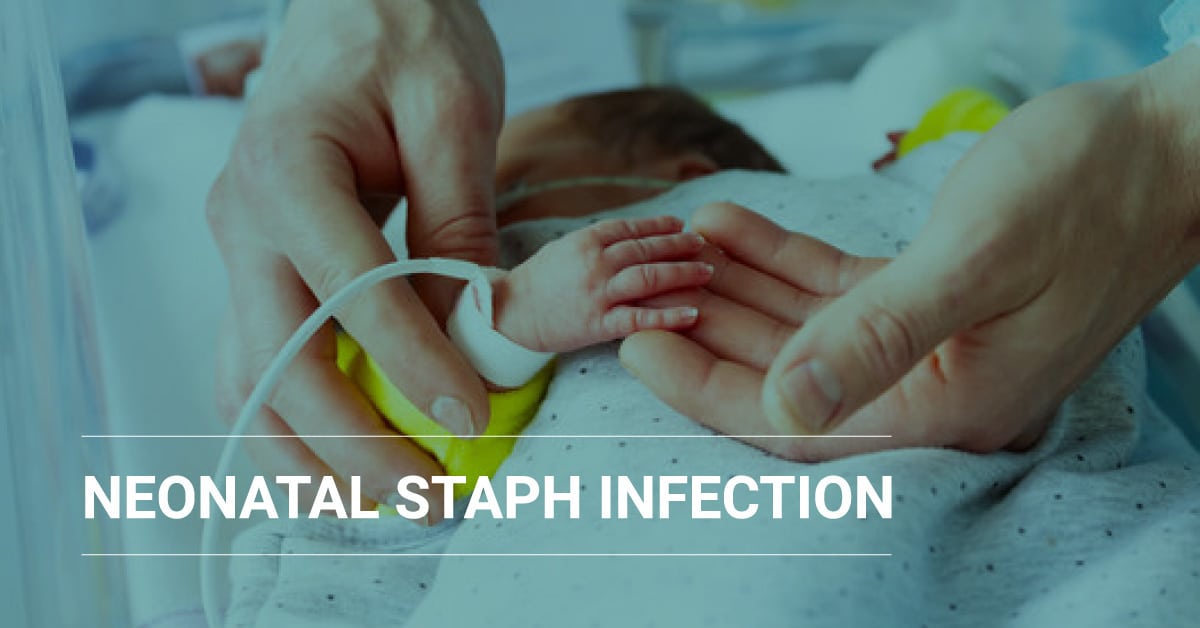
After your baby is born, they may need to spend anywhere from a few days to several months in the hospital. While a specialized hospital unit like the neonatal intensive care unit (NICU) is often the best and safest place for a newborn to be, it also comes with certain risks. This is particularly true when it comes to staph infections.
There are more than 30 types of staphylococcus bacteria, many of which can be found on our skin and in our noses. In many cases, this bacteria is not harmful unless it travels deeper into the body through a cut, wound, or procedure. For newborns, a staph infection can be serious and may even lead to birth injuries like cerebral palsy, developmental disabilities, and brain damage.
Proper hygiene and careful monitoring of newborns for signs of infection can reduce the risk of both staph infections and the possibility of the infection becoming more serious. If your baby has experienced complications from a staph infection that you believe was related to medical negligence, the Birth Injury Lawyers Alliance (BILA) can help. Reach out to schedule a free consultation with a birth injury lawyer in your province.
What Is a Staph Infection?
Staph infections are caused by staphylococcus bacteria. There are many different types of staphylococcus bacteria that can commonly be found on the skin or in the nose. In most cases, these bacteria either do not cause problems or cause minor skin infections.
However, if the staph bacteria enter more deeply into the body – often through a cut or a wound – these infections can be serious or even deadly. More troublingly, many strains of staphylococcus bacteria have become resistant to the antibiotics that are commonly used to treat these infections.
Staph bacteria can cause different types of infections, including:
- Skin infections (the most common type of staph infection, caused by the Staphylococcus aureus bacteria)
- Osteomyelitis, or bone infections
- Bacteremia, or a blood infection that can lead to sepsis
- Endocarditis, or an infection of the inner lining of the heart chambers and valves
- Food poisoning
- Pneumonia
- Toxic shock syndrome
Staph infections are usually treated with oral antibiotics, such as cefazolin, nafcillin, oxacillin, vancomycin, daptomycin, and linezolid. However, if the staph bacteria is antibiotic-resistant, then an intravenous (IV) antibiotic may be necessary. In some cases, wound drainage and/or device removal may be necessary to treat the infection.
How Do Staph Infections Affect Infants?
Staph infections can affect anyone, although people with weakened immune systems and underlying conditions are more susceptible. For newborns, risk factors for a neonatal staph infection include:
- Prematurity
- Low birth weight
- Use of venous catheters
- Invasive medical procedures
- Lengthy hospital stays in the NICU
Babies may acquire staph infections while in the hospital. Otherwise, health hospital staff may carry Staphylococcus bacteria on their skin. If they don’t follow hygiene best practices – such as frequent hand washing – then these bacteria may be transmitted to babies in their care. In addition, newborns may become infected from medical equipment like catheters and ventilators, or through invasive medical procedures.
If staph bacteria enter a baby’s lungs or bloodstream, they can become very sick. Common signs of a neonatal staph infection include:
- Hypothermia (low body temperature)
- Hyperthermia (high body temperature)
- Tachycardia (fast heart rate)
- Bradycardia (slow heart rate)
- Skin lesions, including boils, impetigo, and cellulitis
- Swelling, heat, or redness around a wound
- Swollen skin
- Poor feeding
- Skin rash
- Pus
- Yellow scabs
- Eye styes
- Lethargy
- Irritability
- Vomiting
- Scalded skin syndrome occurs when the staph bacteria make a toxin that affects skin all over the body, causing blisters and eventually red, raw, skin
As with adults, antibiotics are the most common treatment for staph infections. A stronger antibiotic that is administered through an IV may be necessary if the infection is resistant to standard antibiotics like methicillin.
If left untreated – or not treated in time – then a staph infection may progress into a more serious illness. This can include sepsis, which is a bodywide reaction to an infection in the bloodstream. Newborns with sepsis are listless, do not feed well, may have a fever or low body temperature, and may appear to have a gray color. Neonatal sepsis is a serious illness and must be treated promptly to avoid further complications. If sepsis is not treated appropriately, then it can progress into meningitis, which is an infection of the brain and spinal cord. Meningitis can be fatal, so it is important that it is diagnosed and treated immediately. Doctors will take a sample of a baby’s spinal fluid if they suspect that they might have meningitis.
Meningitis is treated with antimicrobial drugs, IV fluids, and anticonvulsant medications if the baby is experiencing seizures. When diagnosed and treated early, bacterial meningitis – such as what may be caused by a neonatal staph infection – is treatable. However, newborns who are diagnosed with bacterial meningitis may suffer from serious health problems, including brain damage, hydrocephalus, developmental disabilities, cerebral palsy, seizure disorders, and hearing loss. Without treatment, a baby with bacterial meningitis has a high risk of death.
Can Neonatal Staph Infections Be Prevented?
As noted above, many people carry staph bacteria on their skin and in their noses. They often have no signs of illness or infection. It is only when the staph bacteria enters the body more deeply that it can lead to serious complications.
The best way to protect newborns from staph infections is to follow basic hygiene protocols. This includes frequent and proper handwashing with an antibacterial soap. When invasive procedures are done, not only should medical professionals carefully wash their hands, but they should use sterile barriers during the procedure. This may include a field or sterile drape, sterile clothing, a cap, a mask, and gloves.
Newborns should be constantly monitored for signs of infection. When a staph infection is caught in its early stages, it can often be treated more easily. In addition, treating a neonatal staph infection promptly reduces the risk of the infection becoming more serious – and leading to more serious complications, such as sepsis and/or meningitis.
In addition to these steps, hospitals should be careful in their use of antibiotics. Overuse of antibiotics is linked to the rise of antibiotic-resistant bacteria, including staph bacteria. This is often more of a systemic problem in hospitals and medical centers that can contribute to more serious staph infections and related complications.
There are also some preventative steps that hospitals can take to prevent newborns from developing staph infections. A recent study found that using a topical antibiotic ointment can prevent staph infections. Specifically, a topical antibiotic called mupirocin applied to the nasal passages and skin of babies in the NICU can help to reduce exposure to staph infections – and the potential for more serious and even deadly complications from staph infections.
How Long Does a Neonatal Staph Infection Last?
The length of time that a neonatal staph infection lasts depends on the type of infection and the severity of the infection. A relatively mild staph infection – like a minor skin infection – can often resolve in a matter of a week or two with treatment. However, more serious neonatal staph infections, like blood or bone infections, can take weeks or months to resolve.
The key with any staph infection is that it is diagnosed quickly and treated immediately. Without proper treatment, a staph infection may progress to something more serious, like septicemia or meningitis. If you believe that your baby’s staph infection was a result of medical negligence, reach out to BILA to schedule a free initial consultation with a birth injury lawyer in your province.
Is MRSA a Type of Staph Infection?
Yes. MRSA is short for methicillin-resistant staphylococcus aureus bacteria. Staphylococcus aureus is a type of staph bacteria often found on the skin, while methicillin is the antibiotic usually used to treat staph infections in newborns. MRSA infections have received a lot of news coverage in recent years due to the rise in this type of infection in hospitals and the difficulty in treating it.
If your baby has MRSA, then a different type of antibiotic may be administered. In many cases, a stronger antibiotic – often administered intravenously – will be necessary. If your baby suffers from complications related to MRSA or another type of staph infection, reach out to BILA to talk to a birth injury lawyer in your province.
Are Neonatal Staph Infections Always Caused by Medical Negligence?
No. Because any person can have staph bacteria on their skin, it is possible for them to pass this bacteria onto a more vulnerable infant. That is why it is so important that anyone who has contact with your baby – including the parents – thoroughly wash their hands before holding an infant.
It can sometimes be difficult to figure out whether a staph infection was caused by medical negligence or another source. Regardless of how the infection was acquired, the key to a good outcome is timely and appropriate treatment. If you have concerns about how your baby may have acquired a staph infection and/or how it was treated, a birth injury lawyer can help. Reach out to BILA today to talk to a lawyer in your province about a potential legal claim for complications related to a staph infection or other birth injury.
Reach Out to BILA Today for Help with Neonatal Staph Infections
Staph infections are generally preventable, with proper handwashing and ensuring that equipment used for medical procedures is sterile. Unfortunately, newborns with underdeveloped immune systems are often at high risk for staph infections – particularly if they spend a prolonged time in the hospital. After a baby has acquired a staph infection, it is incredibly important that it be treated promptly to prevent further infection and complications.
If you believe that your baby may have suffered a preventable birth injury due to complications associated with a staph infection a birth injury lawyer can advise you of your legal options. For help with HIE cases or other types of birth injury claims, call BILA today at 1-800-300-BILA or fill out our online contact form to schedule a free initial consultation with a lawyer in your province.
Related:
Umbilical Cord Problems During Labour and Delivery

John McKiggan, QC has represented clients in pediatric and adult injury claims that have resulted in multi-million dollar awards. In recognition of his accomplishments, John has been honoured by his peers, who elected him president of the Atlantic Provinces Trial Lawyers Association. He has also been named Queen’s Counsel, a designation recognizing exceptional professional merit. John has been selected for inclusion in the Best Lawyers in Canada in the field of personal injury law, he is listed in the Canadian Legal Lexpert Directory and has been named a local litigation star by Benchmark Litigation Canada.
